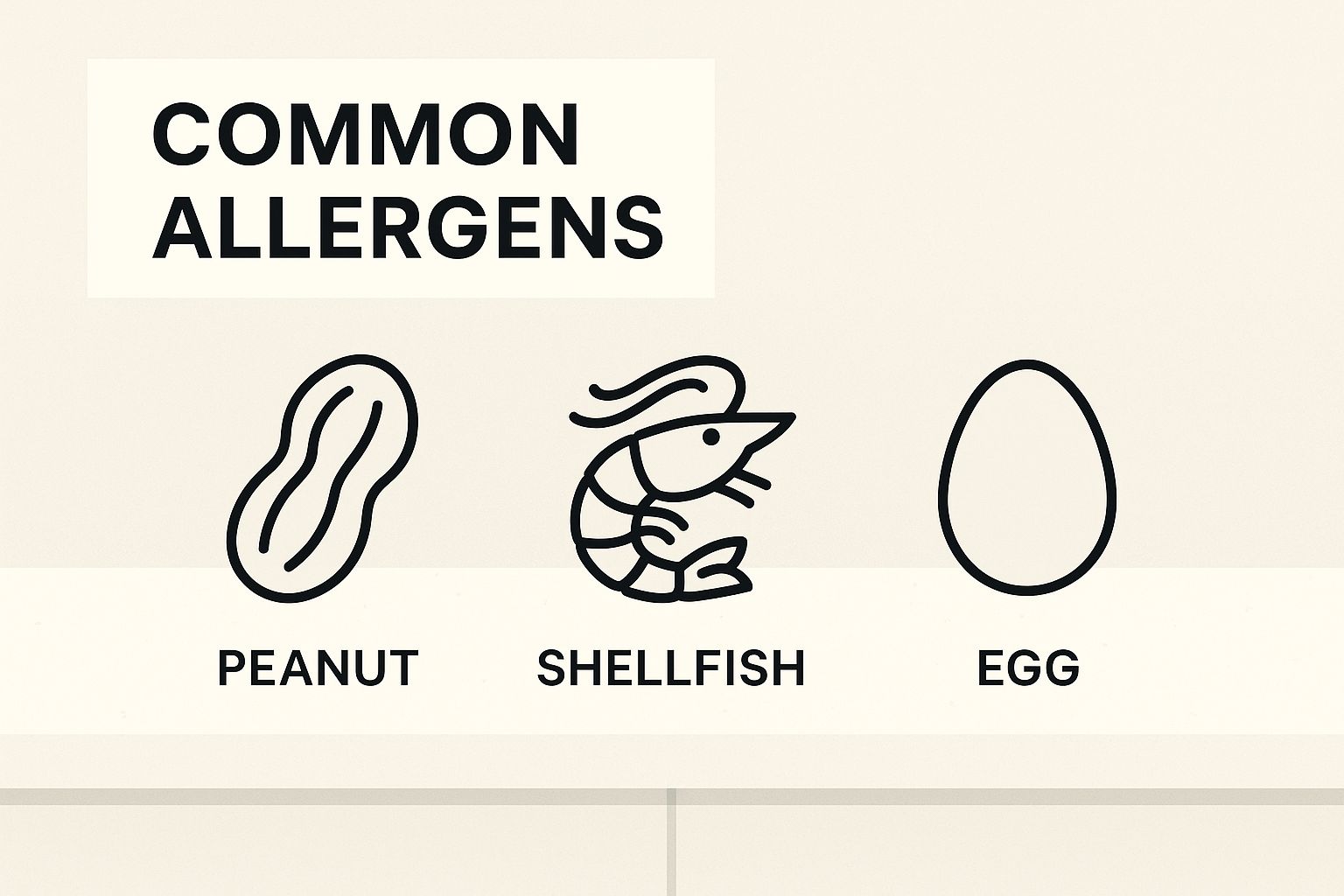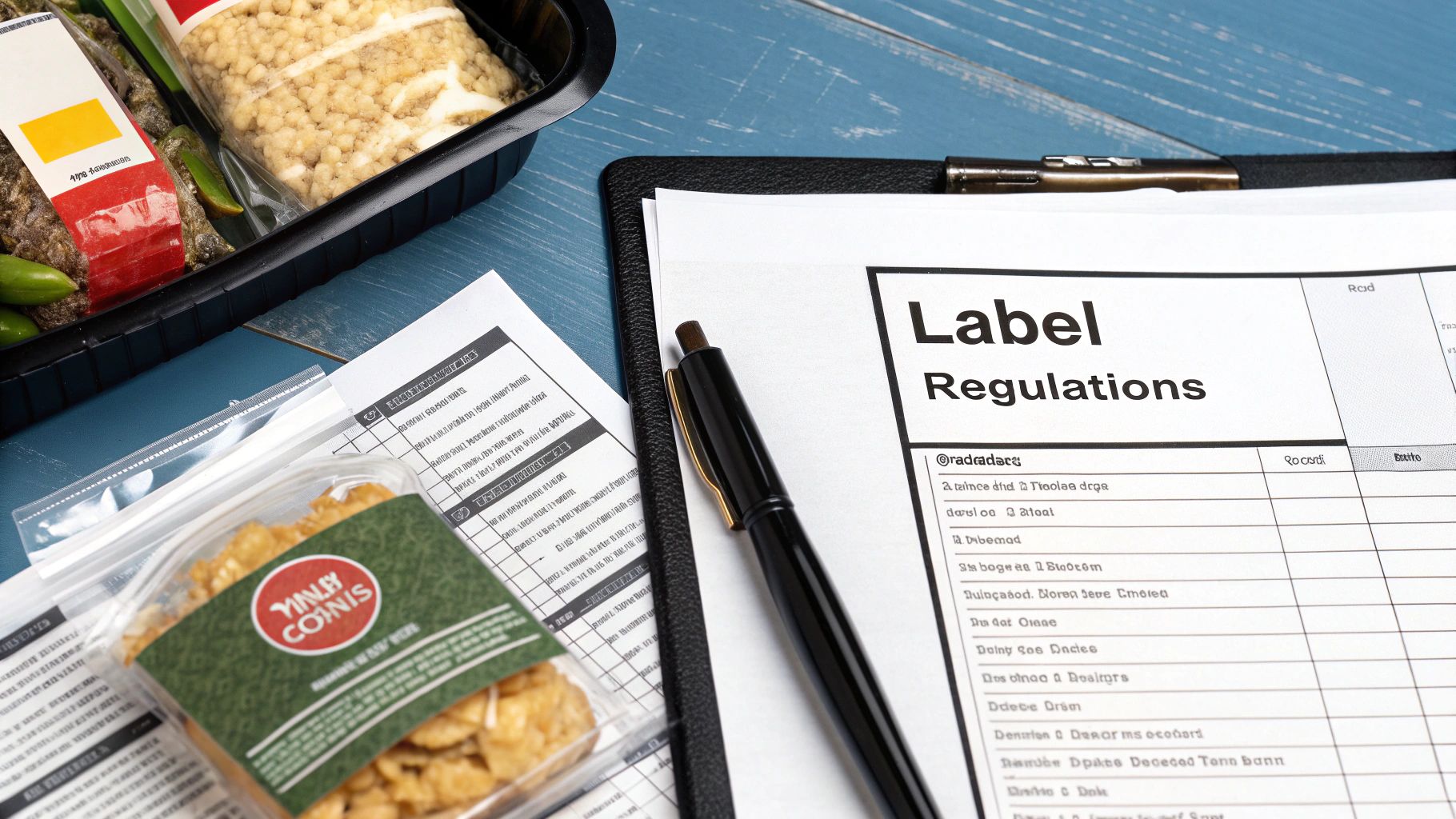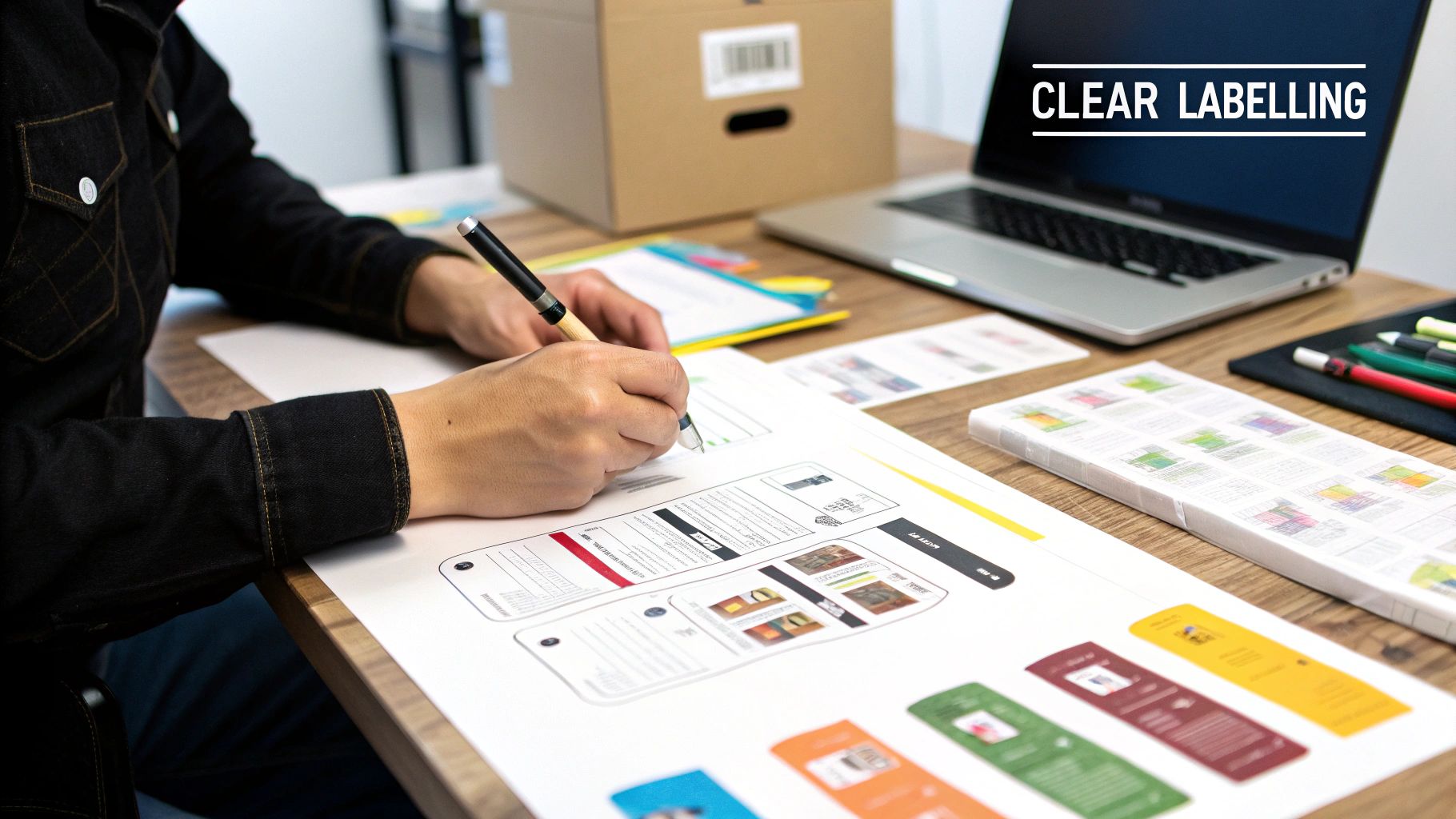When you see certain ingredients in bold on a food label, that is food allergen labelling in action. It is a legal requirement for food businesses to clearly flag major allergens in their products, giving people with allergies a straightforward way to see what is safe for them to eat.
In the UK, clear allergen labelling is not just good practice-it is a cornerstone of food safety. Its purpose is to protect people from potentially severe, and sometimes life-threatening, allergic reactions by being completely transparent about what is inside the packaging. This duty falls on every food business operator, whether you are a large manufacturer or a local village cafe.
At its heart, the system is about communication. When a customer can glance at an ingredients list and instantly spot an allergen, they can confidently avoid something that could make them ill. This builds trust and shows you are serious about your customers’ wellbeing, which is a key part of any food business.
Getting allergen labelling wrong can have serious outcomes. For a customer, accidental exposure can lead to serious health emergencies. For a business, it can mean facing legal action, damaging your reputation, and losing the trust you have worked so hard to build. This is not just about ticking a regulatory box; it is a fundamental part of public health.
Food allergies are more common than many people realise, affecting an estimated 2 million people in the UK. This is not a niche issue, which is why the law is so strict. UK legislation is built around 14 major allergens that must be explicitly declared on any packaging. This applies whether they are a main component or a minor ingredient tucked away in a sauce or additive. From peanuts and milk to less obvious ones like mustard and celery, the rules are comprehensive. You can explore more key food allergy facts and figures at CPD Online.
Clear and accurate food allergen labelling is the first line of defence for people with food allergies. It gives them the power to make informed decisions and safely manage their condition without fear.
To stay on the right side of the law, every UK food business needs to know this list inside out. It covers the most common triggers for food allergies and intolerances, and you are legally required to declare them.
Here is a quick-reference table to help you keep them all straight.
| Allergen Category | Examples |
|---|---|
| Cereals containing gluten | Wheat (like spelt and Khorasan wheat), rye, barley, and oats |
| Crustaceans | Crabs, lobster, prawns, scampi |
| Eggs | Often found in cakes, sauces, mayonnaise, pasta |
| Fish | All species of finned fish |
| Peanuts | A common allergen in sauces, desserts, and oils |
| Soybeans | Used in tofu, soy sauce, and as an ingredient in many processed foods |
| Milk | A component of butter, cheese, cream, and yoghurt |
| Nuts | Specifically tree nuts like almonds, hazelnuts, walnuts, cashews |
| Celery | Includes stalks, leaves, seeds, and the root vegetable celeriac |
| Mustard | Found in seeds, powders, and prepared sauces |
| Sesame seeds | Often present in bread, oils, and tahini |
| Sulphur dioxide and sulphites | Preservatives in dried fruit and some drinks (at concentrations above 10mg/kg or 10mg/litre) |
| Lupin | A flower, but its seeds and flour can be in baked goods and pasta |
| Molluscs | Mussels, clams, oysters, snails, and squid |
Committing these 14 allergens to memory and building your production process around them is the first step towards creating labels that are compliant and genuinely helpful for your customers.
Getting to grips with the legal side of food allergen labelling is non-negotiable for any food business in the UK. The rules exist for a good reason: to give consumers clear, accurate information so they can make safe choices. At the heart of it all are two key pieces of legislation that you need to know.
First is the foundational Food Information Regulations 2014 (FIR). This is the main one, covering most prepackaged foods – think of anything packaged before it is put on a shelf for sale, like a sealed sandwich in a supermarket or a jar of pasta sauce. The FIR mandates that the 14 major allergens must be clearly highlighted in the ingredients list every time they appear.
This infographic shows some of the most common allergens that regulations require to be clearly identified on packaging.

Visual aids like these icons are a great way to reinforce how important it is to pinpoint the specific ingredients that pose a risk to people with allergies.
A more recent development was the introduction of Natasha’s Law in October 2021. This law zooms in on a specific category of food: items that are Prepacked for Direct Sale (PPDS). What does that mean? It is food that is packaged on the same premises from which it is sold, before the customer orders it.
Classic examples include a salad pot made and packed in a café kitchen to be sold from a chiller cabinet later that day, or a baker bagging up croissants to be sold from a display shelf. Before this law, these items often had no individual ingredient labels. For a deeper look into recent changes, you can review our 2025 guide to labelling for food products.
Born from tragic incidents involving undeclared allergens, Natasha’s Law was created to close a dangerous information gap. Now, it is a legal requirement for all PPDS foods to have a full ingredients list with allergens marked directly on the packaging. This was a huge step forward for consumer safety.
Knowing which rules apply to your products comes down to how they are packaged and sold. It is a subtle but critical distinction for staying compliant.
Getting the rules right is one thing, but designing a label that communicates allergen information clearly is a different challenge. It is about thoughtful presentation. When someone with a severe allergy picks up your product, they need to find what they are looking for instantly, without any confusion. Your job is to make that critical safety information impossible to miss.
The most common and legally required way to do this is by making allergens stand out in the ingredients list. You are not just listing them; you are putting up a visual flag so they can be spotted straight away.

This approach is effective because it puts the allergen warnings exactly where most people expect to find them-within the full list of ingredients.
To meet the regulations and give your customers the clearest possible information, your design choices are critical. The golden rule here is consistency. Whichever method you pick to highlight an allergen, you must stick with it for every allergen on that label.
Here are the usual methods:
On top of marking text, some producers add a separate ‘contains’ statement. This is a simple summary box that might say, “Contains: Wheat, Milk, Soya.” While it is a helpful touch for extra clarity, it is critical to remember that this does not replace the legal requirement to highlight allergens within the main ingredients list itself.
Your number one priority should be readability. A beautifully designed label that buries allergen information in tiny, low-contrast text is not just unhelpful-it is a compliance failure waiting to happen.
Even with good intentions, some common design mistakes can make a compliant label hard to read. A classic issue is font size. The legal minimum is a 1.2mm x-height (that is the height of a lowercase ‘x’), which can still be a struggle for many people. It is safer to go a little larger.
Poor colour contrast is another frequent offender. Light grey text on a white background, for instance, is a nightmare for readability. You should aim for a strong, clear contrast between your text and its background. For businesses that need to print consistently professional labels, looking into different food labelling printers can provide the quality and legibility you need every time.
Finally, resist the temptation to use overly decorative or complex fonts for your ingredients list. When it comes to conveying this kind of critical safety information, a simple, clean typeface always wins.
Great allergen labelling is not just about what you deliberately put in your food. It is also about managing the risk of cross-contamination-that is when tiny amounts of an allergen accidentally get from one food into another. In any setting where multiple ingredients are present, this is a major concern.
For any food producer, stopping this accidental transfer has to be a top priority. A busy production line or kitchen can be an allergen minefield if you are not careful. It is like painting with different colours on the same canvas; if you do not clean your brushes properly between dips, you will end up with a muddy mess. The same logic applies to things like gluten, nuts, or dairy.

This is where Precautionary Allergen Labelling (PAL), or ‘may contain’ statements, come in. You have seen them on packaging: phrases like “may contain traces of nuts” or “made in a factory that also handles soya.” These warnings serve a very specific and serious purpose.
A ‘may contain’ warning should never be a guess or a lazy fallback for poor food safety. It should only be used after a business has completed a thorough, documented risk assessment and concluded that, even with the tightest controls, the risk of cross-contamination cannot be completely ruled out.
Using these statements without a genuine risk dilutes their meaning and needlessly limits choices for people with allergies. Failing to use one when there is a real risk can have serious outcomes. The stakes are high.
A precautionary ‘may contain’ statement is a business’s final safety net, not its first line of defence. It should only be used to communicate a real, unavoidable risk of allergen cross-contamination to the consumer.
Getting on top of cross-contamination risk is not about one single fix. It is about building a structured system of organised behaviours and protocols that become part of your everyday routine.
Here are a few practical steps any food business can take:
By taking these proactive steps, you can manage allergens with confidence and use your food labelling to protect your customers.
Labelling allergens by hand is a recipe for disaster. It is not just slow; it is wide open to human error. A simple slip-up, like someone forgetting to update a label after a recipe tweak, can have massive outcomes. We are talking serious compliance breaches and, more critically, putting your customers in real danger.
This is where technology steps in. It takes what was once a manual, risky chore and turns it into a reliable, automated system.
Automated labelling machines are built for one thing: getting it right, every time. They pull information directly from a central database, which removes the chance of someone grabbing an old, incorrect label. An ingredient supplier changes? Recipe adjusted? You update it once in the system, and every label printed from that moment on is 100% accurate.
The real magic of modern labelling systems is how well they work with other software you are already using. Picture your labelling machine talking directly to your recipe management software. This creates a simple, closed loop for your data.
This kind of integration is not just about making life easier; it is about giving you complete confidence that your food allergen labelling is always correct. It transforms a high-stakes, complex task into just another smooth, efficient part of your day-to-day operations.
Relying on technology for labelling is not about replacing people. It is about giving your team the best possible tools to perform a critical job every time. Think of it as a safety net that protects both your customers and your business from costly mistakes.
For any food business serious about getting allergen management right, bringing in an automated system is the logical next step. These systems quickly pay for themselves by cutting down on waste from mislabelled products, freeing up staff time, and protecting your hard-earned reputation.
You can explore the different types of food labelling machinery available to see what kind of solution would best fit your production scale and needs.
By letting technology handle the critical task of declaring allergens, you free up your team to focus on what they do best: creating fantastic food. It is a smart investment in food safety, operational efficiency, and the trust your customers place in you.
Even with the regulations laid out, the day-to-day practicalities often leave food businesses scratching their heads. Getting to grips with the specifics of allergen labelling can feel overwhelming at first, but walking through the common questions is the best way to build confidence and do right by your customers.
Here, we will tackle some of the most frequent queries we hear, turning those legal must-dos into clear, actionable steps for your business.
One of the biggest points of confusion is the difference between “free-from” and “may contain”. They might both talk about allergens, but they serve opposite purposes. Getting this wrong is not just a minor error; it can have serious safety implications.
Think of it this way: a “free-from” label is a confident declaration of what is not in the product, while a “may contain” label is an honest heads-up about a potential risk that cannot be eliminated.
What about food that is not sold in a sealed packet? Think of items from a deli counter, a local bakery, or meals served in a café. The rules still apply, but the way you provide the information is more flexible. You do not need to stick a label on every sausage roll or sandwich.
For these non-prepacked foods, the key is making certain the allergen information is easily accessible to the customer. You could have trained staff provide this verbally, but you must have a clear sign telling people how to get that information. Something as simple as, “Have an allergy? Please speak to our team,” works perfectly.
The critical part is having accurate, written records on-site to back this up, confirming every staff member gives out the same correct information. It is a smart blend of good customer service and robust safety, a principle that applies in many other sectors where clear communication is needed, as seen in the importance of labelling in healthcare.
UK law is very clear: allergens must stand out in the ingredients list. The point is to make them impossible to miss with a quick glance. You are not just listing what is inside; you are actively flagging potential risks for your customers.
The single most important rule for highlighting allergens is consistency. Whatever method you choose-be it bolding, italics, or colour-you must apply it to every allergen on that label, every time. This is not just good practice; it is a legal requirement.
The most common and effective ways to do this are:
Of these, bold text has become the industry standard. It is clean, easy to read, and something shoppers have come to expect.
For businesses looking to achieve consistently accurate and compliant food allergen labelling, Sessions UK provides a full range of labelling machinery designed for precision and reliability. Explore our solutions to find the perfect fit for your production needs.
Copyright © 2025 Sessions Label Solutions Ltd.